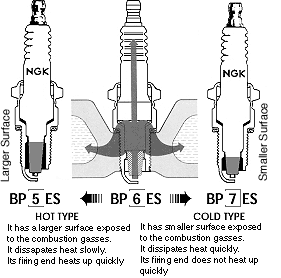
14 mm PLUGS IN AUSTIN 7 HEADS
14 mm plugs came in with the new 3-bearing engine in the Ruby on 16th June 1936 and the plugs to use are: NGK B5HS or B6HS or Champion L86C (the original L10 is no longer available).
The number in the middle of an NGK plug gives its heat range. A spark plug is said to be "hot" if it is a better heat insulator, keeping more heat in the tip of the spark plug. A spark plug is said to be "cold" if it can conduct more heat out of the spark plug tip and lower the tip's temperature and is a measure of the spark plug's ability to remove heat from the combustion chamber. The insulator nose length is the distance from the firing tip of the insulator to the point where insulator meets the metal shell. Since the insulator tip is the hottest part of the spark plug, the tip temperature is a primary factor in pre-ignition and fouling. Whether the spark plugs are fitted in a lawnmower, boat, or a race car, the spark plug tip temperature must remain between 500C-850°C. If the tip temperature is lower than 500°C, the insulator area surrounding the centre electrode will not be hot enough to burn off carbon and combustion chamber deposits. These accumulated deposits can result in spark plug fouling leading to misfire. If the tip temperature is higher than 850°C the spark plug will overheat which may cause the ceramic around the centre electrode to blister and the electrodes to melt. This may lead to pre-ignition/detonation and expensive engine damage. In identical spark plug types, the difference from one heat range to the next is the ability to remove approximately 70°C to 100°C from the combustion chamber. A projected style spark plug firing tip temperature is increased by 10°C to 20°C. A hot spark plug maintains a higher internal operating temperature to burn off oil and carbon deposits, and has no relationship to spark quality or intensity. Conversely, a cold spark plug has a shorter insulator nose and absorbs more combustion chamber heat. This heat travels a shorter distance, and allows the plug to operate at a lower internal temperature. A colder heat range is necessary when the engine is modified for performance, subjected to heavy loads, or is run at a high rpm for a significant period of time.
The conclusion of all this is that if you get oiling-up of
your plugs then move to a ‘hotter’ plug, i.e. one with a lower number. Much more
information can be found on NGK’s website at:
www.ngksparkplugs.com/.

|
Austin 7: 14mm Plugs |
||
|
|
|
|
|
Make |
Type |
|
|
|
|
|
|
Champion |
L10 |
|
|
|
L10 S |
|
|
|
L86 C |
|
|
NGK |
B5 HS |
|
|
|
B6 HS |
|
|
KLG |
777 |
|
|
|
|
|
|
Lodge |
C14 |
|
|
|
HN |
|
|
Wipac |
P4 |
|
|
Bosch |
W175 T1 |
|
|
Esso |
8612 |
|
|
Superfire |
GSP 4266 |
|